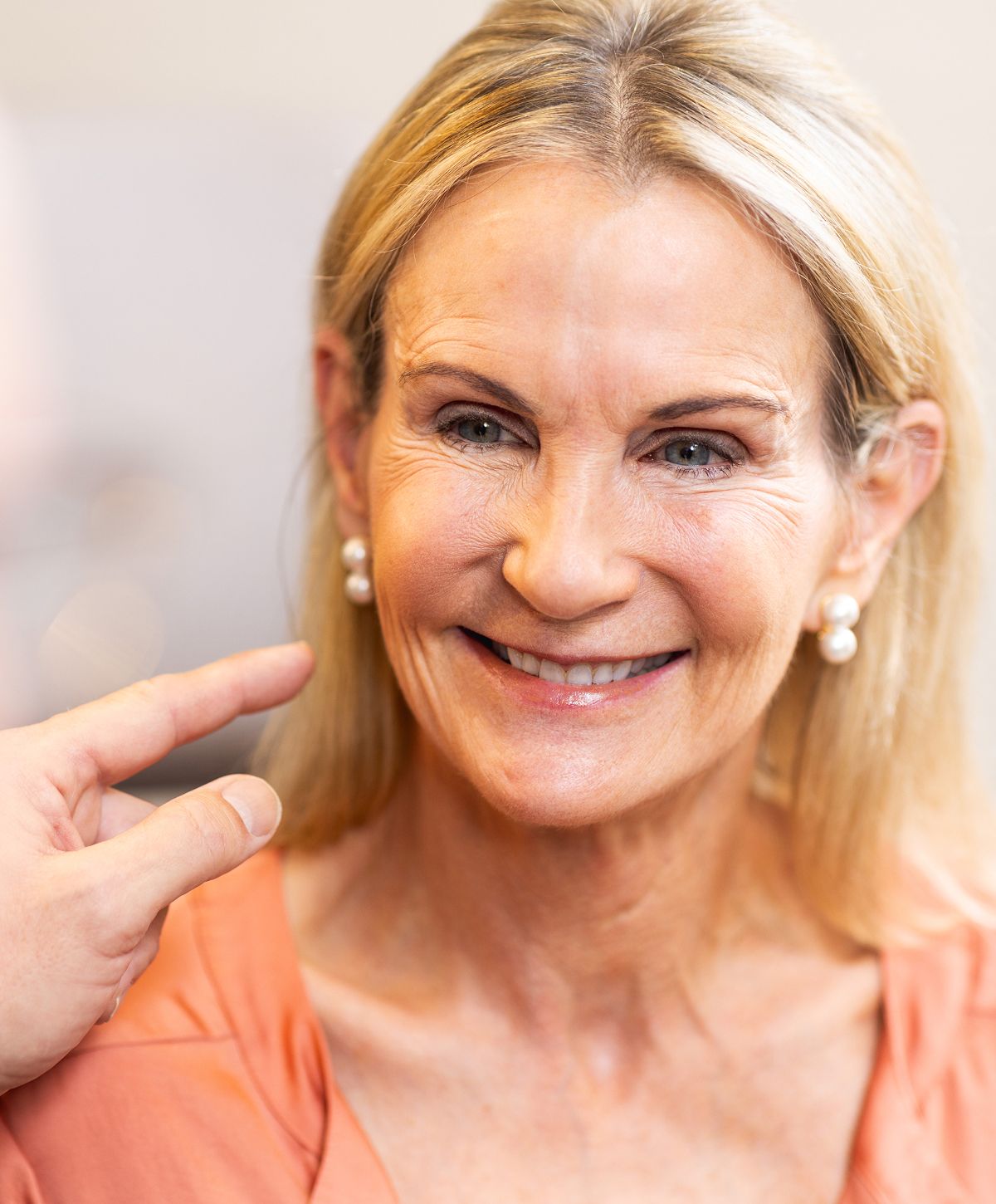placeholder

As we get older, our facial appearance can change — often dramatically. As time marches on, skin that was once lush, smooth, and dewy can easily become wrinkled, loose, and leathery. Until we find an actual fountain of youth, one of the best ways to eliminate fine lines and wrinkles on the face is by having a facelift.
1 of 36
"An Incredible Surgeon..."
"This man is a WIZARD! Extremely skilled, very caring, kind and an incredible surgeon. Consultation was excellent. Dr. Lapuerta is lovely and truly takes the time to understand your goals and discuss options in detail so you know your choices and can align them with your expectations and desired outcomes. Also, his team is incredible! Everyone from office staff, to consultants, to medical professionals - all of his team - wonderful, caring, kind, supportive and very helpful. And the surgical results are five star: I look like myself, but 20 years younger. I am not even exaggerating. All care, instruction - pre and post op - very thorough. You feel like the whole team is there for you every step of the way. Because they are."
Review from L.W. | source: RealSelf | nov 09, 2023 Plastic Surgery Patient
Houston residents considering this procedure are bound to have some questions about the process, and it’s a wise idea to speak with a facelift surgeon. Houston locals are lucky to have access to our own Dr. Lapuerta — with 30+ years experience and over 30,000 procedures under his belt, he brings a wealth of knowledge and great care to his practice. Many patients have misconceptions about what a facelift involves. Some incorrectly associate it with a whole-face treatment that results in an unnatural, “wind blown” appearance. In actuality, a facelift addresses the mid and lower face and neck area.
At our practice in Houston facelift surgery can treat common signs of aging such as wrinkles, sagging skin, facial muscle laxity, jowls, and loose skin in the mid to lower face and neck. If aging of the upper face is of concern, areas from the cheekbones up can be addressed with brow lift surgery, eyelid surgery, and injectable products. The goal of a facelift is to reset the clock on the aging face in a manner that is soft and natural. Many patients consult with Dr. Lapuerta regarding a sagging neck or jowls but had never even considered a facelift. In reality, these patients are the perfect candidates for a facelift. The facelift is a less invasive cosmetic procedure that addresses both skin and muscle changes associated with aging — and the results are effective. Unlike techniques such as lasers or surface treatments, which produce variable to minimal results or improvements, a facelift will produce tangible results.


When exploring cosmetic procedures, the first step is to confirm if you are an ideal candidate. Facelifts are no different. In general, an ideal facelift candidate is in overall good health and a non-smoker. The ideal candidate is also seeking to improve the appearance of their face and or neck by addressing the following issues with a facelift:
Before embarking on any medical treatment, the next step is for a patient to gain an understanding of the expected outcome of the procedure. Prior to any surgical procedure, Dr. Lapuerta sits down with every patient to make sure they fully comprehend each step of the surgery, as well as what they can expect the surgery to accomplish. Our goal during any facelift surgery is to provide a resulting aesthetic that meets the patient’s goals while always remaining natural-looking.
During a consultation, Dr. Lapuerta will examine the patient’s face, discuss their goals, and review their medical history in order to determine which technique will deliver the best results. Below are some of the most commonly used facelift surgery techniques.
A mini facelift is geared toward patients who only have minimal skin laxity. With a mini facelift, only skin is removed, resulting in a smaller scar. Patients with minimal skin and/or tissue laxity or volume loss may be good candidates for a combination of BOTOX®, facial fillers, and fat injections. The use of injectables can achieve both a degree of lift and restore loss of volume. Dr. Lapuerta can help determine if a mini facelift or a combination of Botox and injectables will be able to achieve the improvements a patient is seeking. A mini facelift will not address any of the underlying tissue layers below the skin. Most patients considering a facelift have moderate to severe skin and tissue laxity and are better served by other facelift techniques, which Dr. Lapuerta can also assist with.
Facelifts originally involved only removing excess skin and pulling that skin under tension back towards the ears. Beginning in the 1980s through the mid 1990s, surgeons recognized the importance of the underlying tissue known as the SMAS (superficial musculoaponeurotic system). The facelift technique was altered to address skin laxity and tissue laxity by now including both removal of excess skin as well as addressing the underlying tissue layers.While this technique was an improvement over prior facelift techniques, it can be associated with an unnatural look. It also has a greater risk of damaging the facial nerves.
In the mid to late 90s, a new approach for facelift surgery was introduced. The MACS lift (or Minimal Access Cranial Suspension facelift) offered several advantages over the traditional SMAS or Deep Plan SMAS facelift more commonly performed at the time.The MACS lift is an excellent facelift option for patients with moderate skin and tissue laxity. The MACS lift is also sometimes called a “short scar” facelift as it is less invasive and leaves a shorter scar than the SMAS or Deep Plan SMAS. This technique, which uses an incision in front of the ear instead of behind it, allows for the correction of sagging facial features using a minimal incision. Another benefit of the MACS technique is that the surgery requires less operation and recovery times than other techniques.
Developed in Europe, the Modified MACS removes excess skin, suspends the underlying tissue layers (involving the SMAS) in a vertical direction, includes liposuction to the neck area and below the chin, pulls the neck muscles beneath the chin area together and uses a suture technique to lift and support the neck and jaw to provide a smooth jaw line.
Small incisions are made just below the chin, around the front of the ear, and behind the ear. The modified MACS works well for patients with moderate amounts of skin and tissue laxity. There are less risks to the underlying facial nerves and it produces a long lasting, natural appearance. The procedure takes only about 3-4 hours and patients experience a quicker recovery.
The Modified MACS Facelift is Dr. Lapuerta’s preferred technique for the majority of his patients. For patients with more severe skin and tissue laxity, Dr. Lapuerta incorporates aspects of the Traditional SMAS facelift to provide patients the best aspects of all techniques available.
Dr. Lapuerta creates an individualized approach for all of his facelift patients and may recommend additional options. These options include:
Frequently, patients will also elect to include upper or lower eyelid surgery (blepharoplasty) or a forehead lift. This allows patients to reset the clock on all aspects of facial aging with one surgery and one recovery.
Depending on the type of facelift planned and the patient’s medical history, a facelift can be performed under oral sedation with local anesthesia, under deep I.V. sedation with local anesthesia, or under general anesthesia with local anesthesia. The length of the surgery will vary, depending on the planned approach, from 3–6 hours. Regardless of the method of anesthesia planned, Dr. Lapuerta only works in fully accredited surgical facilities.
Some surgeons will perform a facelift surgery in an office exam room or procedure room with only oral sedation and local anesthesia. This option is usually promoted by the surgeon as a way to lower cost for the patient and allows the surgeon to avoid the expense, maintenance, and oversight associated with becoming an accredited surgical facility. Patients should be aware that an in-office procedure leaves the entirety of their care — including monitoring vital signs, anesthesiology, and the surgical procedure — in the hands of one person, who also may be overseeing an assistant. Most facelift patients are in their 50s or older. They may have health issues or be uncomfortable lying flat and still for several hours during a surgery. Patients should carefully consider their own health history and the potential disadvantages concerning their comfort, health, and safety when considering a facelift in an office only vs. an accredited surgical facility environment.
Dr. Lapuerta has privileges at eight of Houston’s most prestigious hospitals as well as an on-site, office based, AAAASF fully accredited surgical facility, The Plastic Surgery Institute of SE Texas (PSI). This surgery is considered an outpatient procedure, but some patients may be more appropriate to have surgery in a hospital setting with an overnight stay. The vast majority of patients, regardless of age, who have a stable medical history prefer to have their surgery done at the PSI. PSI offers patients a familiar environment with friendly faces they know and recognize, privacy, ease of access, private area for family or friends to wait — and usually the cost is slightly less than a hospital.
Patients have peace of mind knowing that in addition to Dr. Lapuerta, a medical doctor trained in Anesthesiology will be present, as well as a Registered Nurse and a Certified Scrub Technician. The PSI AAAASF accreditation assures patients that safety standards are met, maintained, and evaluated by a third party for all equipment, physical plant, and personnel.
Wondering what to expect after facelift surgery? Many patients only require over the counter Tylenol for pain control or only a couple of days of prescription pain medication. The use of local anesthesia during surgery helps to make facelift surgery one of the least painful cosmetic surgeries. Most patients report minimal discomfort in the postoperative period. Patients are encouraged to keep their head elevated to assist with the resolution of swelling.
Facelift Surgery Recovery Time
If you’re concerned about being able to make time for a facelift surgery, we have some good news for you: this procedure doesn’t require too much down-time. Patients are usually able to return to work and their everyday routine in as little as a week, although they should hold off on strenuous activity for several weeks. Patients who work from home are frequently able to work the first day after surgery. Dramatic changes will be visible approximately six weeks after the facelift and healing will continue for up to six months.


Each facelift surgery is unique and will be tailored to meet the needs and goals of each patient. Because of the customization required to consider the type of facelift for optimal results, it can make it difficult to come up with one accurate blanket price of a facelift.
For example, a less invasive or skin-only facelift is usually somewhere between $10,000-$16,000+, while more invasive procedures, such as the SMAS facelift or the deep plane facelift, can run anywhere between $8,500-$14,000+. RealSelf.com lists the average cost of a facelift at $11,050. With these ballpark figures, we highly recommend that anyone considering this procedure actually speaks with a doctor for an accurate quote.
We would love for you to come and visit Dr. Lapuerta for a facelift consultation. During the consultation, Dr. Lapuerta will carefully listen to your needs and desired results, and determine the best way to make those goals a reality. It’s this level of care and commitment which has earned us the reputation of being the best facelift Houston has to offer. To learn more or to schedule a facelift consultation, contact Dr. Lapuerta today.

Recovery time
Average Procedure time
Post-op Follow-up
Procedure Recovery Location
2-3 Weeks
4-6 Hours
1 Day
In & Outpatient

A facelift is a surgical procedure designed to remove or reduce visible signs of aging on the face. Though there are different variations of this procedure, a facelift will always involve surgical “lifting” of facial or neck skin, and pulling/stretching it back. This results in a smoother, tighter, and younger-looking complexion!
Anaesthetic will depend on both one’s medical history as well as the type of facelift they are undergoing. The options are: 1) Under oral sedation with local anesthesia 2) Deep I.V. sedation with local anesthesia 3) Under general anesthesia with local anesthesia
You can expect your facelift to last for a long time — most patients retain their results for a whole decade.